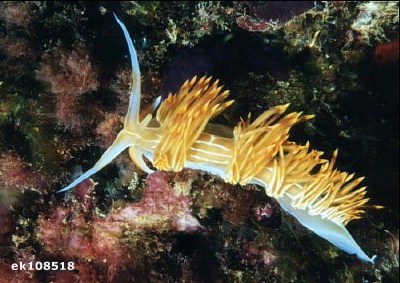
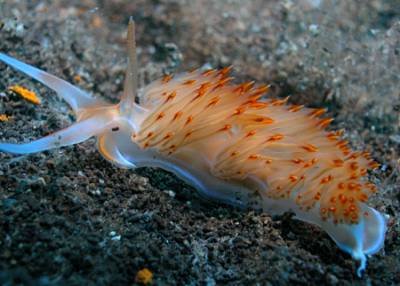
Dondice banyulensis
Portmann & Sandmeier, 1960
Order: NUDIBRANCHIA
Suborder: AEOLIDINA
Family: Glaucidae
DISTRIBUTION
Mediterranean and nearby Atlantic coastal waters
PHOTO
Upper: Spain, Cala Joncols (Costa Brava): size 64 mm, depth 17 m, April 20, 2000, divesite "La Caverna" Photo: Erwin Koehler.
Lower: Dugi Otok Island, Croatia, Mediterranean Sea. Photo: Robert Borzymek
Grows to about 70mm in length. It has a characteristic white median line down the body and another along each side beneath the cerata. The rhinophores are lamellate, the lamellae completely encircling the rhinophore.
See Erwin Koehler's message below.
Reference:
• Portmann, A. & Sandmeier, E. (1960). Dondice banyulensis sp. nov. un Eolidien nouveau de la Méditeranée. Rev. Suisse Zool. 67: 159-168, text figs. 1-6
Rudman, W.B., 2000 (June 23) Dondice banyulensis Portmann & Sandmeier, 1960. [In] Sea Slug Forum. Australian Museum, Sydney. Available from http://www.seaslugforum.net/find/dondbany
Related messages
Dondice banyulensis from Portugal
March 28, 2008
From: Joao Pedro Silva
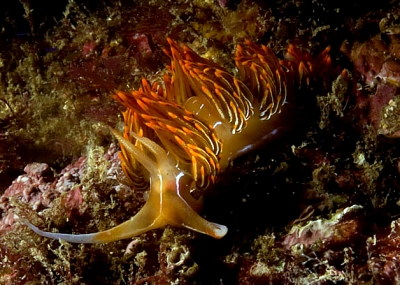
Dear Bill,
As I was reading the available info on Dondice banyulensis I got the feeling it's not a common find outside the Mediterranean.
Well, during 2 weeks last October I found several individuals (quite large, aprox. 8 cm long) in Sesimbra, Portugal. And I've also seen them before several times further north in Peniche and Baleal (aprox. 120 km north of Sesimbra). Far less common than other species, like Flabellina babai or Hypselodoris villafranca (and other "blue cousins"), but still a species one can find every now and then.
Locality: Sesimbra, Baleeira spot, 18, Portugal, North Atlantic, 14 October 2007, mostly sandy bottom with occasional rocks. Length: ~8cm. Photographer: Joao Pedro Silva.
I'm yet to find them mating, spawning and feeding.
Cheers,
Joao Pedro
jpsilva@uwphotographer.net
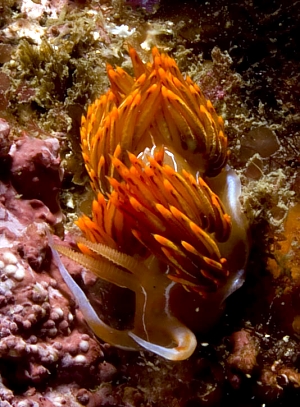
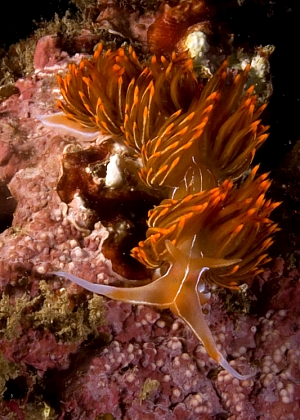
Dear Joao Pedro,
I think Dondice banyulensis is quite well known on the Atlantic coast of the Iberian Peninsula [see message #9028] but as with many species, we have to be careful to work out whether lack of records of an animal from a particular place is because the animal is actually absent or rare there, or because there are not many observers looking for them. Thanks for the nice photos.
Best wishes,
Bill Rudman
Juvenile of Dondice banyulensis with its food
March 25, 2008
From: Miquel Pontes
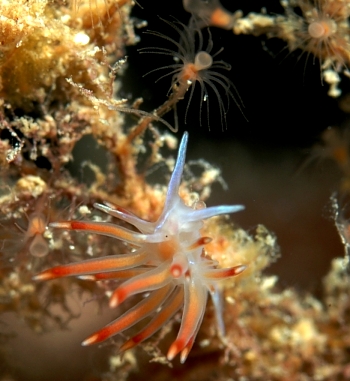
Dear Bill,
In our last dive we found this juvenile seaslug that we believe to be a Dondice banyulensis, despite the rhinophores are not ringed as they are in adult specimens.
However, what is curious from the picture is the fact the D. banyulensis is surrounded by beautiful Eudendrium (?) which I believe it feeds on.
Locality: Platja de Caials, Cadaqués, Costa Brava, 8 metres, Spain, Mediterranean Sea, 27 october 2007, Rocky precoraligen. Length: 12-15 mm.. Photographer: Miquel Pontes.
Best regards,
Miquel Pontes
http://marenostrum.org
info@marenostrum.org
Pontes, M., 2008 (Mar 25) Juvenile of Dondice banyulensis with its food. [Message in] Sea Slug Forum. Australian Museum, Sydney. Available from http://www.seaslugforum.net/find/21046Thanks Miquel,
Juveniles can be quite difficult to identify. I woud be interested by comments in the identity of this animal as the arrangement of the cerata - and their size - seem a bit unusual for Dondice banyulensis.
Best wishes,
Bill Rudman
Dondice banyulensis from Marseille, France
July 26, 2006
From: Nadine Neels
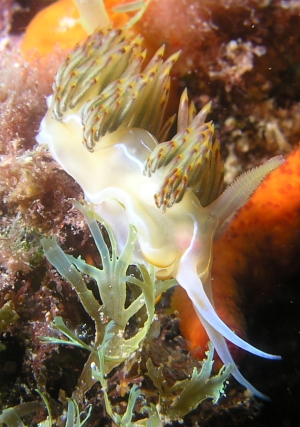
I would like to know which kind of "seaslug" we have seen in June in Marseille (France). In the different books we have, we can't find anything similar. If you could help us to determine what it is we would be grateful.
Locality: Marseille, 15 metres, France, Mediterranean Sea, 23 June 2006, Clear. Length: 5 cm. Photographer: Nadine Neels
Thanks.
Nadine Neels
neelsnadine@yahoo.fr
Nadine N., 2006 (Jul 26) Dondice banyulensis from Marseille, France. [Message in] Sea Slug Forum. Australian Museum, Sydney. Available from http://www.seaslugforum.net/find/17196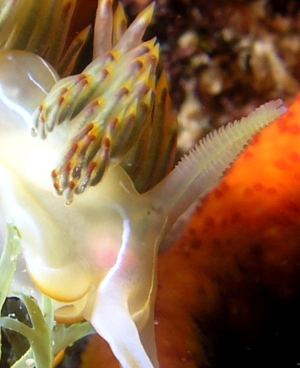
Dear Nadine,
This is Dondice banyulensis. It is quite variable in colour so it is possible the photos you have seen in books were of different colour forms. Have a look at the message attached to the Fact Sheet for photos of the various colour variations.
Best wishes,
Bill Rudman
Dondice banyulensis and Flabellina lineata
June 1, 2006
From: Dominique Horst
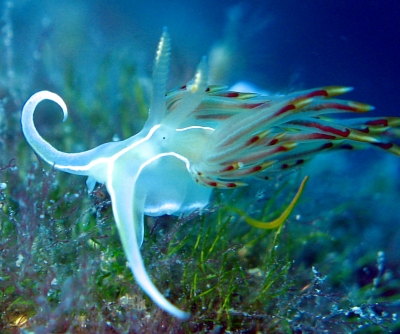
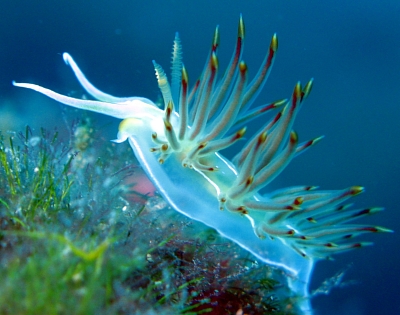
Hello,
I am confused again about the identification of this nudibranch. I thought initially it was Flabellina lineata, because the general color and the white line. I think now that it may be Dondice banyulensis, as the white line is double along the body and the rhinophores are circled. But until now the color of those I met was very orange...
Locality: Cap d'Antibes, 25m, Antibes, France, Mediterranean sea, 21 May 2006, rocks on sand. Length: 15-20mm. Photographer: Dominique Horst.
If you could confirm the identification please,.
Many thanks in advance,
Dominique
dominique.horst@wanadoo.fr
Horst, D., 2006 (Jun 1) Dondice banyulensis and Flabellina lineata. [Message in] Sea Slug Forum. Australian Museum, Sydney. Available from http://www.seaslugforum.net/find/16687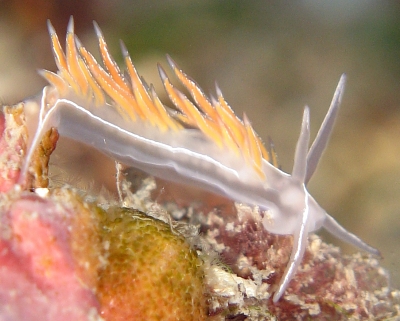
Dear Dominique,
The two upper photos are of Dondice banyulensis and the lowest one, alongside my reply, is Flabellina lineata. Although distinctive features of a colour pattern, like white lines, can be a valuable identification tool, they can also be a bit of a trap if they blind us to other characters which are saying something different.
In the upper photos, the shape of the rhinophores, with spaced but very distinctive ridges or rings, the arrangement of the cerata, and the position of the white line between the ceratal groups, are all characteristic of D. banyulensis.
The animal in the lower photo also has white lines, but it has them in different places. For example the line on the oral tentacles runs along the top of the tentacle, not along the front, which is where it is in D. banyulensis. And the line along the side of the body is far below the ceratal groups, not between them. Another distinctive difference is that the rhinophores are smooth, not ridged, and there are broken white lines on the cerata.
Thanks for the nice photos of both species,
Best wishes,
Bill Rudman
Dondice banyulensis from Portugal
May 11, 2006
From: David Abecasis
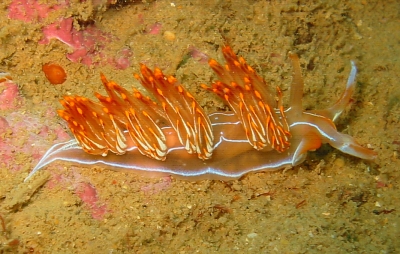
Dear Bill,
I'm sending a photo of Dondice banyulensis from Portugal. From what I have read, this species is endemic to the Mediterranean with few records from outside.
Locality: Faro, 8 metres, Portugal, Atlantic Ocean, 19 December 2005. Photographer: Frederico Oliveira.
Best regards,
David Abecasis
davidbecas@netcabo.pt
Abecasis, D., 2006 (May 11) Dondice banyulensis from Portugal. [Message in] Sea Slug Forum. Australian Museum, Sydney. Available from http://www.seaslugforum.net/find/16522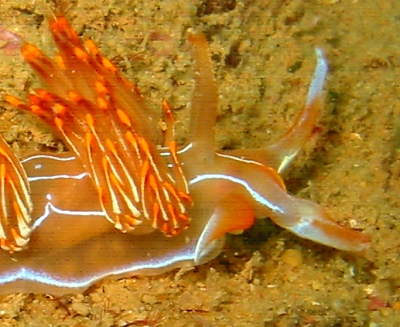
Dear David,
Thanks for this record. It is nice to get another photo of this species, especially from outside its normal range. Lucas Cervera [message #9028] posted some records of it from Atlantic Spain and Portugal a few years ago.
Best wishes,
Bill Rudman
Dondice banyulensis from Croatia [2]
October 11, 2003
From: Adam Petrusek
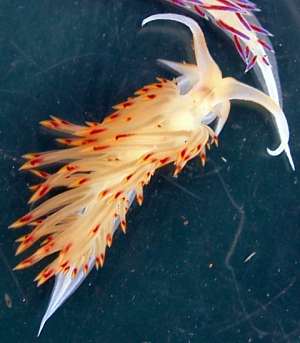
Dear Bill,
Here is the mystery animal that is in my photo of Cratena peregrina. The general morphology looks fairly similar but I am sure it's different. Can you help?
Lcality: Adriatic sea, near Sumartin, island Brac, Croatia. September 2002
Photographed on the Petri dish during the Mediterranean Marine Fauna excursion of the Charles University, Prague. Photo: Adam Petrusek.
All the best
Adam
petrusek@cesnet.cz
Petrusek, A., 2003 (Oct 11) Dondice banyulensis from Croatia [2]. [Message in] Sea Slug Forum. Australian Museum, Sydney. Available from http://www.seaslugforum.net/find/11198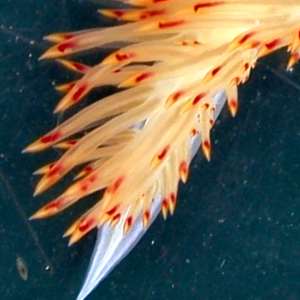
Dear Adam,
This is Dondice banyulensis. By coincidence I have recently posted a message from Robert Borzymek reporting this species in Croatia.
Best wishes
Bill Rudman
Dondice banyulensis from Croatia
October 3, 2003
From: Robert Borzymek

Hi,
This photo was taken in Croatia - Dugi Otok Island, Mediterranean Sea. Please help with identification.
Best regards,
Robert Borzymek
www.underwater.pl
r.borzymek@millenniumdivers.mcnet.pl
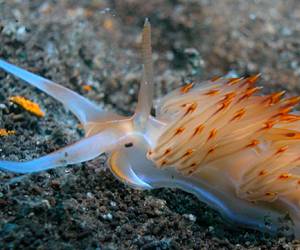
Dear Robert,
This is Dondice banyulensis. Yoiu can see traces of the thin white line down the midline of the head which forks to run out on to each oral tentacle.
Best wishes
Bill Rudman
Re: Is Dondice banyulensis a Mediterranean endemic?
January 23, 2003
From: J. L. Cervera
Dear Miquel,
Concerning your question. Here are published records of Dondice banyulensis in Atlantic waters:
• García-Gómez, J. C., Cervera, J. L., García, F. J., Ortea, J. A., García-Martín, S. F., Medina, A. & Burnay, L. P.(1991). Resultados de la campaña international de biologia marina "Algarve 88": moluscos opistobranquios. Bolletino Malacologico, 27 (5-9): 125-138.
• Calado, G. & Urgorri, V. (1999). Additions and new data on Portuguese Opisthobranchs. Bolletino Malacologico, 35 (5-8): 97-102.
• Calado, G., Urgorri, V., Gaspar, R. & Cristobo, F. J. (1999). Catálogo de los moluscos opistobranquios bentónicos de las costas de Setúbal-Espichel (Portugal). Nova acta científica Compostelana (Bioloxía), 9: 285-294.
• Malaquias, M. A. E. & Morenito, P. M. (2000). The Opisthobranchs (Mollusca: Gastropoda) of the Coastal Lagoon "Ria Formosa" in Southern Portugal. Bolletino Malacologico, 36 (5-8): 117-124.
Regards.
Lucas.
lucas.cervera@uca.es
Thanks Lucas,
Bill Rudman
Is Dondice banyulensis a Mediterranean endemic?
January 22, 2003
From: Miquel Pontes
Hi Bill,
As you all know, Dondice banyulensis is described as endemic to the Mediterranean Sea. But lately I have come across to some observations of this slug in the Atlantic Ocean: 1 find at Tavira, Portugal by Óscar Felgueiras [http://www.medslugs.de/E/Atl-E/Dondice_banyulensis_26.htm] and three findings in the Cantabric Sea (North coast of Spain) according to a report by Inma Fernández.
Do any of you have more reports of Dondice banyulensis outside the Mediterranean Sea? Maybe the distribution area should be revised for this species.
Yours sincerely
Miquel
mpontes@marenostrum.org
Thanks Miquel,
Any records, particularly if accompanied by photos, of Dondice banyulensis from outside the Mediterranean would be welcome
Best wishes,
Bill Rudman
Re: Dondice banyulensis from Turkey
October 2, 2002
From: Baki Yokes
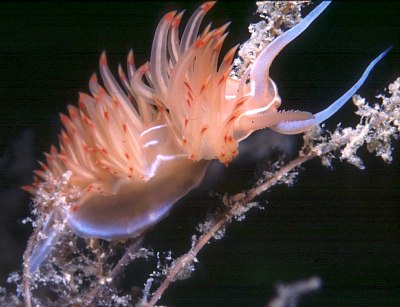
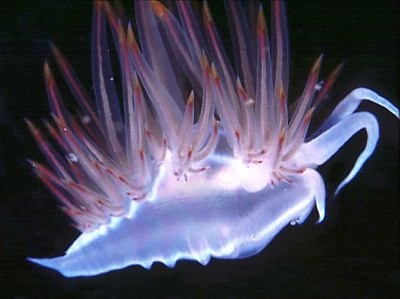
Dear Bill,
I didn't actually consider my message about Dondice banyulensis as a new record for the Eastern Mediterranean, since this species is very common around Turkish coast. It is also found in the Sea of Marmara. The Mditerranean specimens are always brightly coloured, whereas the ones found in the Sea of Marmara are nearly colourless and more translucent.
Upper Image:
Date: May 2002
Place: Antalya, Turkey
Divesite: Uc Adalar
Depth: 12m
Size: 4cm
Lower Image:
Date: October 2001
Place: Ýstanbul, Turkey
Divesite: Meandros
Depth: 25m
Size: 3.5cm
Best regards
Baki
bakiyokes@turk.net
Yokes, B., 2002 (Oct 2) Re: Dondice banyulensis from Turkey. [Message in] Sea Slug Forum. Australian Museum, Sydney. Available from http://www.seaslugforum.net/find/7997Thanks Baki,
Bill Rudman
Slug eating slug - Dondice banyulensis
September 17, 2002
From: Baki Yokes
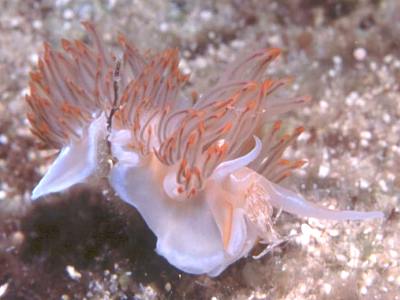
Dear Bill,
Here is a series of photos of a Dondice banyulensis eating another slug. When I first saw them, I thought that the D. banyulensis was eating the last portion of the hydroid colony, on which it was standing. Then I realized that the victim was not a hydroid but a Facelina rubrovittata. The big slug was swallowing the little one, millimeter by milimeter. All of a sudden, D. banyulensis squeezed the F. rubrovittata and half of the animal fell down. After chewing the last portion for a few seconds, D. banyulensis started to search for the rest of the meal. I didn't know if the F. rubrovittata could survive, but at that moment, with its halved foot, it was moving much faster than its predator.
Up to now, I only knew that D. banyulensis feeds on hydroid colonies. In Gary McDonald & James Nybakken's List of the Worldwide Food Habits of Nudibranchs, Flabellina pedata and Flabellina affinis are also listed on the menu for D. banyulensis. All these Aeolids (D. banyulensis, F. affinis, F. pedata, F. rubrovittata) feed on hydroids of the genus Eudendrium. As these slugs store the nematocysts of the cnidarians they eat, on their cerata, is it possible that, D. banyulensis misidentifies these slugs as a delicious hydroid colony? Or is it just a competetion for the same kind of foodstuff, since the food is scarce?
Upper Right: Dondice eating Facelina. Lower Left: Half eaten Facelina escaping. Lower Right: Facelina caught again. Antalya, Turkey, Dive site: Uc Adalar. Depth: 18m, Sept.1, 2002. Photos: Baki Yokes.
Best wishes
Baki
bakiyokes@turk.net
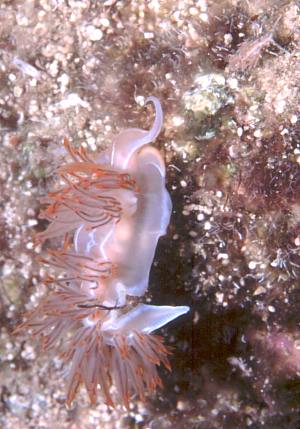
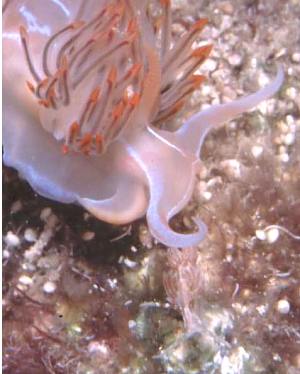
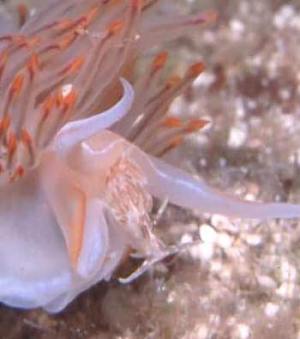
Dear Baki,
Thanks for this interesting observation and wonderful photos. I've included a closeup alongside. While I guess it is possible Dondice mistakes its aeolid prey as hydroids, I suspect its much more likely that it is just a voracious carnivore which feeds on these aeolids because they feed on the same hydroid colonies and so are 'available'. There are a number of glaucid aeolids with a reputation for feeding on things other than their standard hydroid food. It's never a good idea when collecting to put glaucids together in collecting jars as 'tragedies' often occur.
Best wishes,
Bill Rudman
Dondice banyulensis from Turkey
September 17, 2002
From: Baki
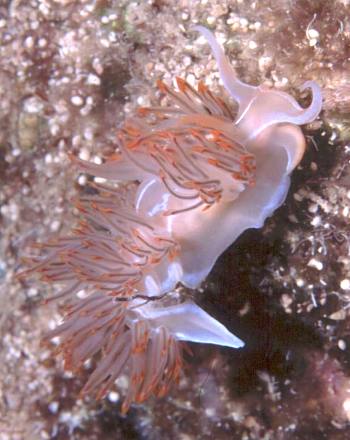
I thought I would add this photo of Dondice banyulensis to accompany my message 'Slug eating slug'.
Date: Sept.1, 2002
Place: Antalya, Turkey
Dive site: Uc Adalar
Depth: 18m
Photo: Baki Yokes
Baki
bakiyokes@turk.net
Yokes, B., 2002 (Sep 17) Dondice banyulensis from Turkey. [Message in] Sea Slug Forum. Australian Museum, Sydney. Available from http://www.seaslugforum.net/find/7966Thanks Baki,
I suspect this is another new record from your part of the Mediterranean.
Best wishes,
Bill Rudman
Dondice banyulensis from French Mediterranean
July 25, 2002
From: Marina Poddubetskaia
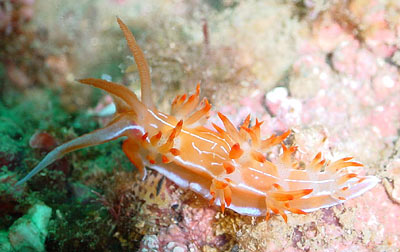
Dear Bill,
Here are some photos of Dondice banyulensis.
Date: July 02, 2002
Location: Cerbere, France
Site Cap Negre
Depth: 21m
Size: upper right, lower left = 4-5cm; bottom right = 6-7cm
Best wishes,
Marina.
Photos: Marina Poddubetskaia - Nembro website
nembro@nembro.info
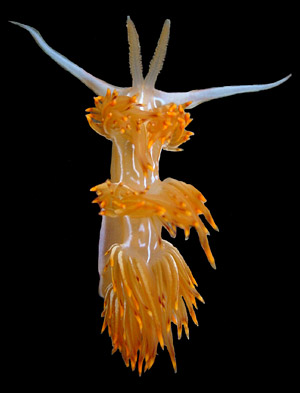
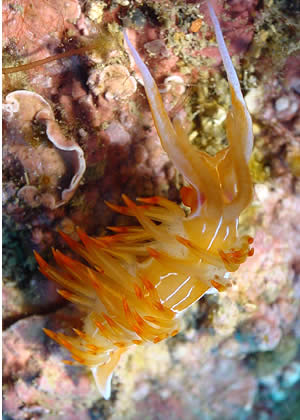
Thanks Marina,
Bill Rudman
Dondice banyulensis from nthn Spain
March 18, 2001
From: Bernard Picton
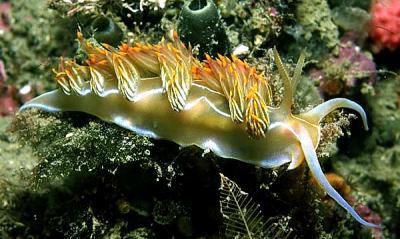
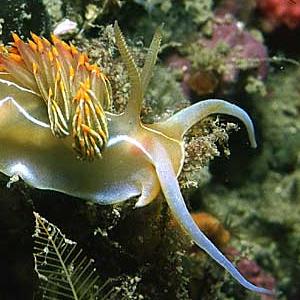
Hi Bill,
Here's a nice side view of Dondice banyulensis if you'd like to add it to your page for that species.
Medas Is, NE Spain - May 1987
Bernard
bernard.picton.um@nics.gov.uk
Picton, B., 2001 (Mar 18) Dondice banyulensis from nthn Spain. [Message in] Sea Slug Forum. Australian Museum, Sydney. Available from http://www.seaslugforum.net/find/4007Thanks Bernard,
Its shows the lamellate rhinophores well.
Bill Rudman.
A photo of Dondice banyulensis
February 24, 2001
From: Arnaud Parenty

Hi
I was diving next to the marine park of Banyuls (Mediterranean coast of France). I was doing a training course on nudibranchs. During this week, we counted about 30 different species of sea slugs. I've made this photo of Dondice banyulensis with a single use camera in an ikelit box.
not so bad ;)
Regards
Arnaud Parenty
arnaud.parenty@icsn.cnrs-gif.fr
Parenty, A., 2001 (Feb 24) A photo of Dondice banyulensis. [Message in] Sea Slug Forum. Australian Museum, Sydney. Available from http://www.seaslugforum.net/find/3860Dear Arnaud,
Not bad at all. I hope you enjoyed your nudibranch course.
Best wishes,
Bill Rudman
Observations on Dondice banyulensis
June 24, 2000
From: Erwin Koehler

Dear Bill,
Here are some 'action shots' of Dondice banyulensis (egg-ribbon, feeding and mating). All photos were made in Spain, Cala Joncols (Costa Brava):
•ek087302 size approx 6 cm, depth 12 m, May 05, 1998, divesite "La Caverna"
•ek108123 size 57 mm, depth 15 m, April 18, 2000, divesite "Cabo Caverna"
•ek108518 size 64 mm, depth 17 m, April 20, 2000, divesite "La Caverna"
•ek108524 size 64 mm and 55 mm, depth 17 m, April 20, 2000, divesite "La Caverna"
The animal in ek108518 followed pretty fast the track of the other one, and when they got in contact they started bristling and whipping their cerata (like a Diadem urchin does when disturbed), got in mating position (ek108524) going on with this spectacle all the time. That time I really wished I had a video, because this action cannot be recorded in a photo. It looked like a little firework.
Erwin
Medslugs.Koehler@t-online.de
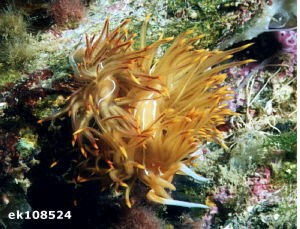
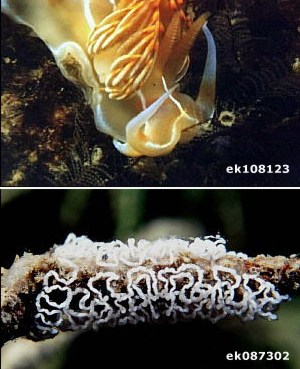
Thanks Erwin,
It's very interesting to hear of them 'bristling' their cerata when mating. I wonder if some of the other species that bristle their cerata, such as Moridilla brocki and Sakuraeolis nungunoides do the same?
Best wishes,
Bill Rudman.
